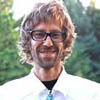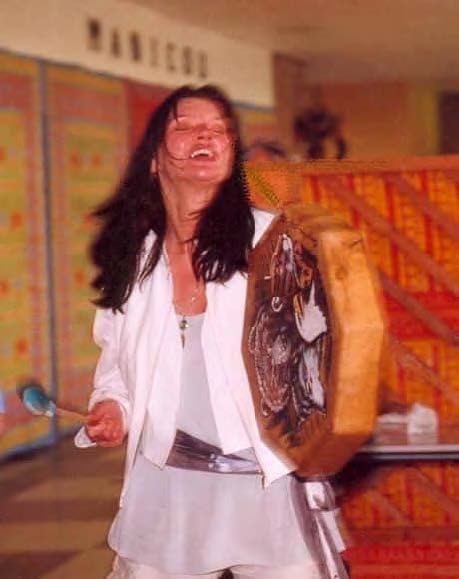It has been said that music makes the invisible visible and brings together the physical and the spiritual, giving voice to images and a felt-sense of the nature of inner reality. Experience shows that this is what takes place while we dream. Whether awake or asleep, a spirit-realm of the imagination opens up to us during night-world and day-world visions.
One of the obstacles we moderns face is our predisposition to literalize our understanding of events. As Storyteller and Mythologist Michael Meade reminds us, “Modernity’s obsession with progress and blind rush to create a future based in technology seems to require a thorough departure from the past. The past, especially the ancient imagination that caused humans to stand and walk with heads in the heavens and feet on the goat’s earth, holds keys that can unlock the literalism of the present and open the future to greater meaning”.1
Applying this stance to the disciplines of dream-work, shamanism and sound healing, it is possible to see beyond the literalizations by which we create isolated entities, thus distorting our view of the world. Something symbolic, and real in its own fashion, comes into play during the practice of these disciplines, helping to weave back together the isolated elements, until we can perceive reality as an integrated “fabric” of great beauty and value.
Tom Cowan, contemporary explorer and writer, has defined shamanistic practice as follows: “The core elements… found in most cultures with a solid shamanic tradition are:
Shamans can voluntarily enter a unique visionary state of consciousness during which
they experience a journey into non-ordinary realms of existence where
they acquire knowledge and power for their own use or for others in their communities”.2
Compare these characteristics with Jeremy Taylor’s description of imaginal engagement: “In Gestalt work with dreams, the dreamer re-enters the dream, re-imagines and re-experiences the dream from the subjective viewpoints of other characters or figures in the dream… even the stones and the trees, conscious and self-aware, will speak with the ‘shamanic’ explorer, offering startling insights, re-framed interpretations of the dream, and deeper understanding of the waking life dramas that the dream reflects and shapes”.3
In working with dreams, we are entering multi-layered realms, which correspond to traditional descriptions of shamanic journeys. This increased awareness of circumstances in the dream-quest, when correlated to the dayworld, benefits the dreamer and the environment in which she or he exists, just as entering non-ordinary states of shamanic travel can enable one to bring back a boon to the collective.
For example, in a recent dream-exploration at a weekend workshop I hosted, we worked with a dream that, according to the dreamer, foretold an unexpected professional transition.
The dreamer is writing computer code in the dream for an actual technology client of his. As he drives away from the dream-jobsite, his car breaks down. He realizes that he needs to back up the computer code he had written so far, aware as well that the “breakdown” of the car could potentially cost him his job with the client. At the end of the dream he feels concerned about finding ways to “continue the project”.
Not long after the dream, the dreamer did, in waking reality, lose his job, yet he was prepared for the loss, due to his having worked on the dream. As a group, we re-imagined this dream, which allowed us to consider the benefits of the messages it contained. We resonated with the dream’s ability to communicate about the future, a lesson in the value of being open to messages from the dream world. Inherent in the central notion of shamanism is the perception that “everything is alive”. The Aboriginal people of Australia, the Ngarinyin, Worora and Wunumbal have a phrase for this, “Yorro Yorro”, which means, “everything standing up alive, brand new”.4 The purpose of reflecting on ideas from various cultures and the living experiences of our dreams is to rediscover a helpful perspective that supports an interrelation among ourselves and the environs in which we live. Similarly, the essence of shamanism, recently resurgent in places like Mongolia5, is the recognition that we are part of an enormous web of life that includes the archetypal-spiritual realm. As the Celts have said, we not only need the help and wisdom of the Otherworld (their name for “non-ordinary reality”), the Otherworld needs us to help tend that realm by making visits to its territories and engaging with its denizens and landscapes.
By taking dreaming one step further, making waking journeys with the support of drumming, music and sound, we’re able to creatively relate with living energies—in the subtle realms of imaginal space, in waking and dreaming worlds—for the benefit of the earth. In this way we support our own deep nature and our connection with the vital living matrix of all life. By seeking to search beyond the limited egocentric orientation of the modern mind-set, amidst the overly wasteful and disconnected culture of the day, we may find previously undreamt of solutions to the brewing eco-psychological dilemmas of our planet. When we experience the reality that “everything is alive”, we can interact with the entities and creations of all the worlds in a responsible, relational fashion. As Taylor puts it, “Too much of the contemporary shamanic revival involves embracing the theatrical trappings of traditional shamanic praxis without grasping the fundamental pragmatic point: everything is alive, and the more I know about and commune with that life, the greater the range of creative possibility I will be able to imagine and manifest. This is as true in dealing with the subtle symbolic energies of computers and automobiles as it is in dealing with animals and ‘illness spirits’”6 —i.e., the shamanic idea that certain “entities”, subtle-energy beings or forces, can cause sickness”.
We’ve helped to shape the waking world we live in; if we can perceive that it’s alive, we may feel and act upon the inherent impulse to care, not just for ourselves, but also for all of life as we can perceive and relate to it. One consequence of such a realization is the challenge to learn how to re-invigorate an approach to living more sustainably and artfully with the technologies we have invented. The effects of sound and music have been studied comprehensively. It has been shown that instruments like the Aboriginal didjeridu, Tibetan singing bowls, Shamanic trance percussion, as well as singing and chanting, support vibrations in the body that are comparable to brainwave patterns found in deep, healing states of consciousness. The sounds projected by these tools have similarly been shown to create levels of harmonious resonance in the minds and bodies of individuals listening to them.7
Following such inspiration, I collaborated with Ben Leinbach in creating a music album entitled “Yoro Yoro”. Some of my own dreams influenced this recording. This musical journey is our effort to evoke the felt sense that there is an ongoing, creative, living energy inside of and surrounding us. In the dream circles I lead, we all chant and I also play flutes, didjeridu, drums and bowls in order to open us to the energies and frequencies of shamanic, dreaming realms. In this work, we re-enter dreams to re-experience and interact creatively with events in the dream, seeking further understanding and wisdom. This practice has been called Conscious or Active Dreaming, and it bears a distinct relation to shamanic journeying. I also lead dream incubation ceremonies where dreamers are invited to seek healing wisdom while recalling or “growing” dreams for themselves and also for the community.
In one such instance, during an on-going group meeting, a participant shared her dream of a Noah’s Ark school bus filled with wild animals and creatures, traveling across the ocean surf near the shore. Together, the entire group re-imagined the dream. Individuals found personal layers of meaning in this “incubatory re-entry practice”. We also found there was a common layer of symbolic engagement in the dream. In our waking experience of this narrative, several of us felt a strong sense that it invited us to bring the energies of our archetypal instincts into closer connection with the solid ground of our embodied earthly existence. Others felt that the dream was connecting us to actual living beings from the Otherworld that wanted us to learn from and relate to them. They wanted us to value their promptings about living a life of wholeness, allowing them to express their natures in our lives, as an antidote to our all-too-human, lop-sided consciousness.
By seeking to reinvent and honor the sacred traditions of shamanism, musical ceremony and dreaming, we may creatively encounter the obstacles we face as humans and co-creators living on the planet at this time. Opening ourselves to the reality of our Dreams, the Otherworld or the Collective Unconscious, we can engage with a much broader range of wise and innovative possibilities, taking into account the entirely real and felt experience that “everything is alive”, which is a natural outgrowth of connecting with these vital and rewarding disciplines.
Endnotes
1 Michael Meade, The Water of Life (Greenfire Press, Mosaic Multicultural Foundation, Seattle Washington, 2006) p. 13
2 Tom Cowan, Fire in the Head (HarperOne, HarperCollins, New York, 1993) p.3
3 Jeremy Taylor, The Wisdom of Your Dreams (Jeremy P. Tarcher, Penguin Group, New York, 1992,2009) pp. 198-199
4 David Mowaljarlai, Jutta Malnic, Yorro Yorro, Aboriginal Creation and the Renewal of Nature (Inner Traditions International, Vermont, 1993) p. 214
5 David Stern, Masters of Ecstasy (National Geographic Magazine, USA, 2012) p.110
6 Jeremy Taylor, The Wisdom of Your Dreams (Jeremy P. Tarcher, Penguin Group, New York, 1992,2009) p. 206
7 Andrew Weil, Kimba Arem, Self-Healing with Sound and Music (Sounds True, Boulder Colorado, 2004) Audio Learning 2 CD Set






